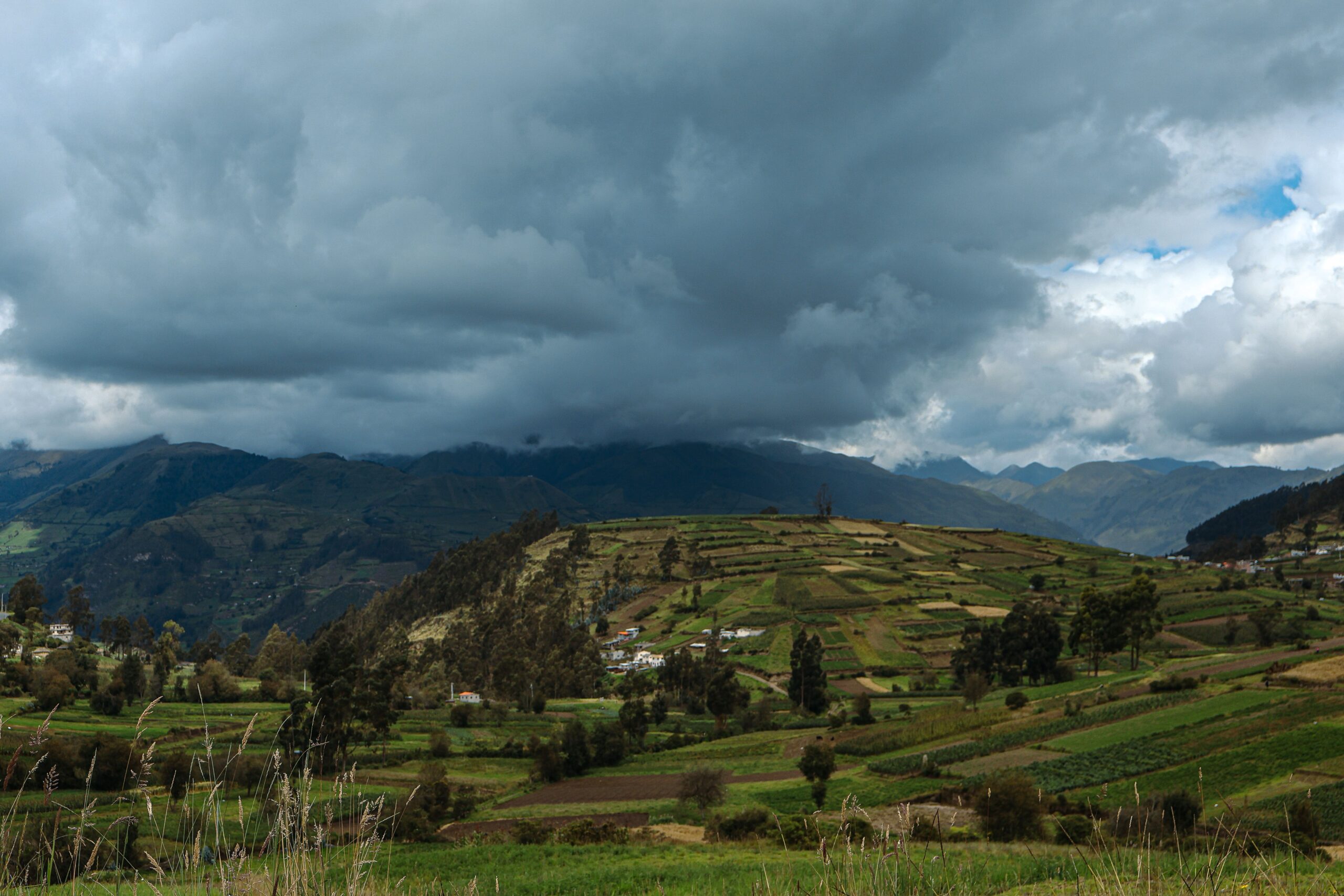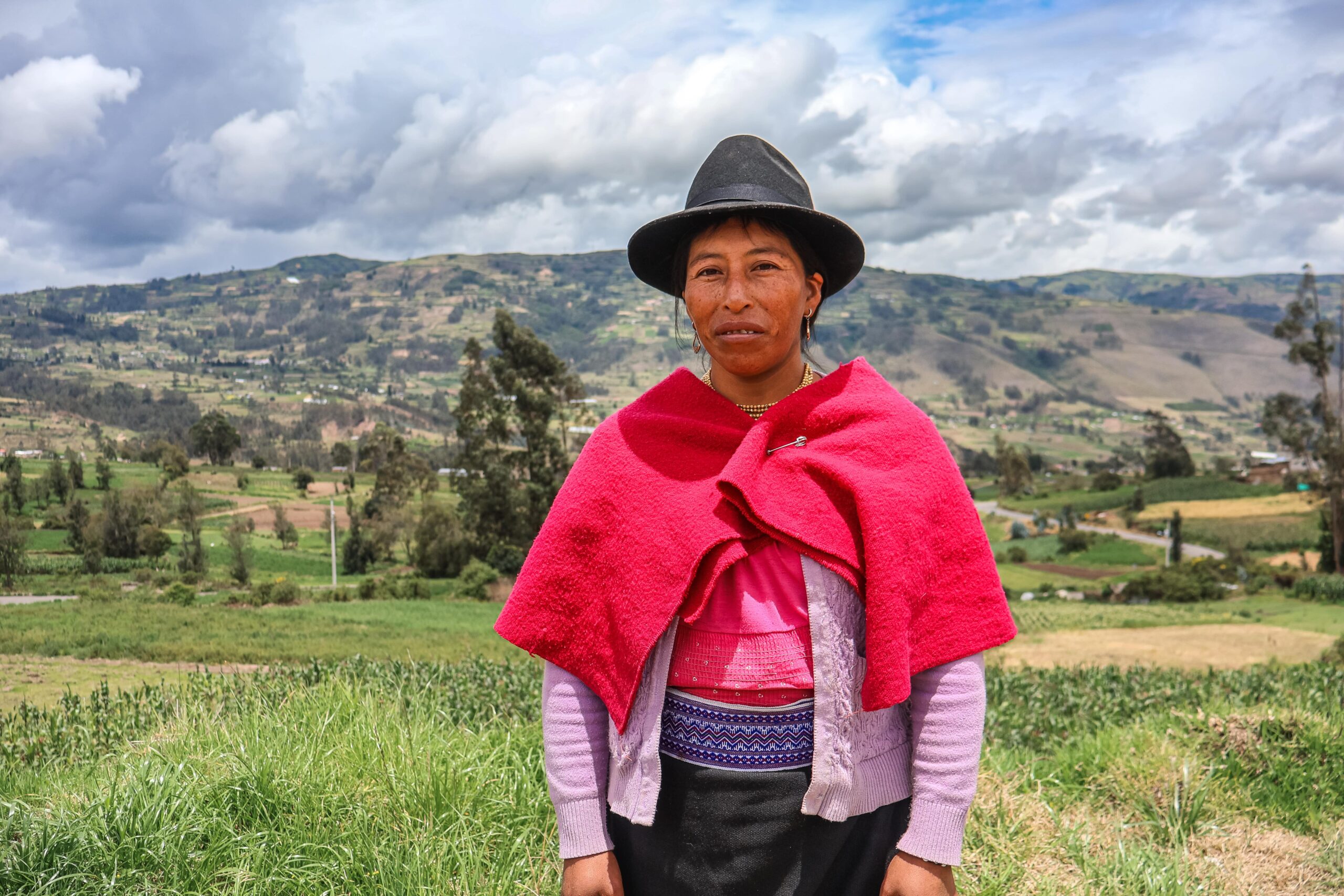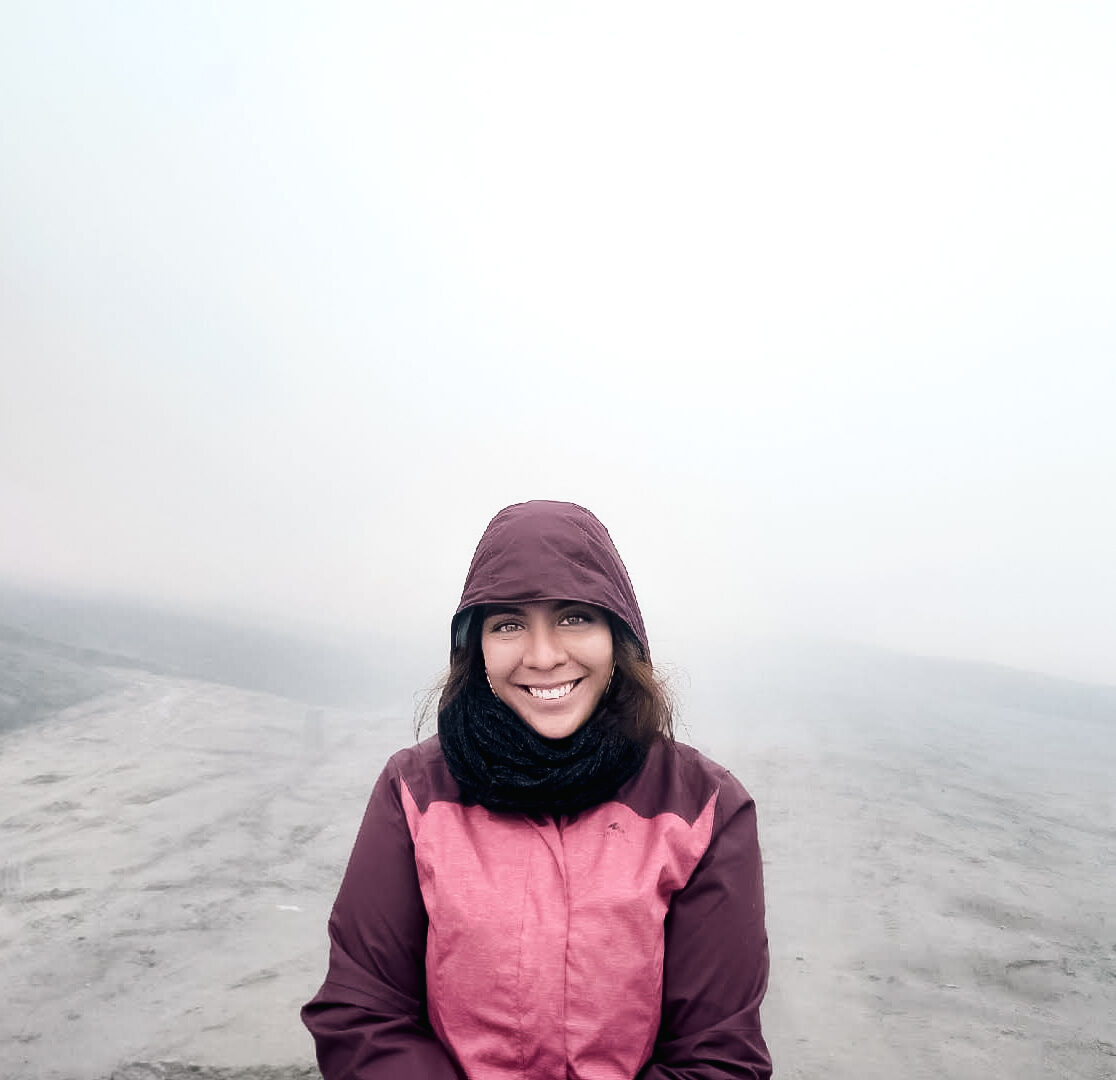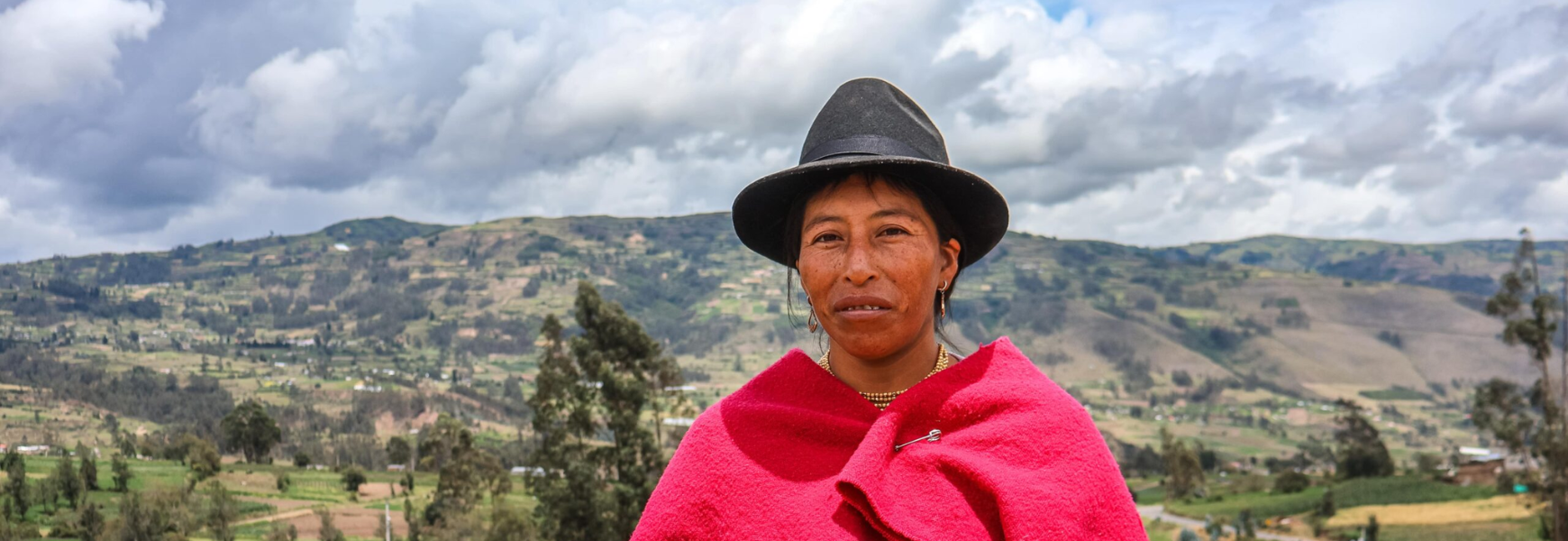Nancy’s hands: from rock to fertile soil
"Nancy speaks slowly, without haste. She says that the earth also teaches, but only to those who listen to it."
This article was originally published in Spanish. Read it here.
Nancy is an Indigenous farmer from the community of Tunshi Grande, Ecuador. Over the last few years, she has participated in a group process supported by our local partner, EkoRural, in which several families redesigned their farms to strengthen production and restore agroecological practices.
The work began with drawing a map of the land. From there, each family organized their plot, located water sources, identified the most fertile soils, and recognized the areas that needed recovery. The redesign enabled crop diversification and the integration of vegetables, grains, tubers, and medicinal species, ensuring year-round food production for self-consumption and surplus sales to local markets.
In this conversation, Nancy talks about how she transformed her land, what she learned along the way, and how working with natural fertilizers changed the way she cares for and understands her chakra.

—Nancy, tell me how this whole process with your land began. What was the first thing you did when you decided to improve the soil and plant differently?
First, we made a map, taking a good look at the land: where the water ran off, where the sun shone the most, and where it was best to work. Then we tilled the land, with help, little by little. At first, it was very difficult because the soil was hard, full of pebbles, and very stony. You would hit it with a shovel, and stones would fly everywhere.
Then we started throwing oats and bugs on it to make green manure. That loosened up the soil a little. Once we made the green manure, we added a little bit of pig manure, animal manure, and sometimes we bought chicken manure. We added all of that little by little, not all at once, but slowly, so that the soil could react.
As we went through the process, the soil changed. It broke down, became more fertile, more ñuta. It was no longer so dry or hard. Before, it was pure rock, but through our effort and homemade fertilizers, it became softer. And when the soil is ñuta (dust), the land produces more. You can see it in everything: the color, the smell, how the grass looks.
—And how did you know the soil was improving? What made you realize it was responding to all that work?
You can see it quickly. At first, the grass was small and thin, and then it started to grow bigger and greener. The soil changes. You put your hand in and you no longer feel the stones, but soft, moist soil. Before, you would plant and very little would grow; now more grows, and it’s more beautiful. But that takes time. It doesn’t happen overnight. You spread the fertilizer and you have to wait three or four months, and then you see the change.
And that makes you happy, because you see the land responding. You get encouraged, you realize that the work is worth it. The land also feels, and when you take care of it, it responds.
—You mentioned that you have animals. Do they also help you in this process of improving the land?
Yes, of course, the animals help a lot. For example, I have a little calf. That calf is already helping me, because its manure is good for the soil. As it decomposes, it feeds the grass, and the grass grows more, greener, stronger, with more nutrients. Likewise, the plants don’t get sick as much anymore. Everything helps: the soil provides grass, the grass feeds the animals, and the animals return to the soil as fertilizer.
That calf is now a year and a half old, and has been pregnant for three months. In the future, I want her to give me milk to sell to the milkmen who come to the community, and also to have some for the house. That way, the cycle is complete: soil, animal, milk, food.
“You get excited, you realize that the work is worth it. The soil also feels, and when you take care of it, it responds.”

—And what have you learned from this whole process? What has working with your hands, with animals, and with the land taught you?
I’ve learned that you have to have knowledge, not just work for the sake of working. You have to know how to care for animals, how to treat them when they get sick. During the rainy season, for example, they often get sick. If the pen isn’t clean, they get fungus, mosquitoes bite them, and then they get pneumonia. That’s why you have to keep them well, in a dry place, covered, so they don’t get wet.
I’ve also learned to watch them. They let you know when something is wrong. If an animal isn’t eating or is lying down a lot, it’s because something is wrong. So you learn by watching, asking questions, and listening. That’s how you learn little by little, with time and work.
—You said something very important: that you now produce without pesticides. How did that change come about, and what do you do to care for your plants without chemicals?
Before, we used chemicals because we thought that was the only thing that worked. If there were a pest infestation, we would buy pesticide and spray it. But that causes damage, not only to the soil, but also to people and animals. So we learned to make our own organic fertilizers using what we have at home and natural ingredients.
For example, we use cheese and cattle manure, and we let it rot a little. We also use hormigio, semita, and other forest plants. We mix all of that together and let it decompose for about two months. With that, we can spray the plants so they grow more and to scare away worms. It also helps prevent the leaves and roots from getting sick.
Little by little, we stopped using chemicals, and now we hardly use them at all. It’s better because it’s healthier for everyone, and the land looks prettier and more alive.


“Little by little, we stopped using chemicals, and now we hardly use them at all. It’s better because it’s healthier for everyone, and the land looks prettier and more alive.”
—And what difference have you noticed since you started working this way, more naturally?
Because we no longer use chemicals that affect us. When you spray with chemicals, you breathe them in, and animals feel it too. And the people who buy what we sell are also affected. But now, with these natural methods, we eat more healthily.
We have a small vegetable garden just for the family, and everything we harvest is clean. The cows eat natural grass; we don’t give them injections or chemicals. We have varied pastures, mixed with different types of grass, which feed them well. That’s where we get the milk we consume, and we grind the barley and mix it with machica and milk to make a sweet treat. Everything is natural, everything is from right here.
And you can feel it in your body. When you eat clean, you have more energy, you sleep better, even your mood changes. You feel more peaceful knowing that what you are eating is not harming you.
—How nice it is to hear you talk about the processes like that. What does it mean to you to be able to produce your own food?
For me, it’s a joy. Knowing that what we eat is ours, that it comes from the land we care for, and that it has no poison in it. It gives us strength, health, and energy. It also makes us proud to see our children eating what we sow and raise.
When you eat natural food, you feel different. It’s another life. You don’t have to buy so much, you don’t have to depend on what comes from outside. And you know where everything comes from: the milk, the potatoes, the corn, the eggs. Everything comes from here, from what you take care of every day.
And that brings peace of mind. Because you work, yes, you get tired, but in the end you know that what you have comes from your efforts and from the land that responds to you. That’s the best reward there is.

—If you could give advice or a message to other people, farmers, or families who want to start working without chemicals, what would you say?
I would tell them to come, to learn, that they are welcome. Not only do they learn, but we also learn from them. That way, we can teach our children to continue caring for the land.
Here in the countryside, some children are malnourished because they no longer eat as they used to. Now they eat more junk food: rice, noodles, cookies, things from the store. That fills them up, but it doesn’t nourish them. Instead, we have everything natural: eggs, barley, morocho sweet corn, roasted corn, corn. All of that gives us strength.
That’s why I say we have to go back to nature, take care of the land, and not use poisons. Because the earth also feels. When you take care of it, it gives back to you. And so little by little you learn, by watching, working, with patience. The earth becomes dust, and you also become strong with it.

“Nancy speaks slowly, without haste. She says that the earth also teaches, but only to those who listen to it.“

About the author
Luisa María Castaño Hernández
Luisa María Castaño Hernández is the Latin America and the Caribbean Communications Coordinator at Groundswell International. She has experience in media in different countries, content development in multimedia and print formats, fiction and non-fiction writing and editing.
She has played a leading role in the formulation and implementation of communication strategies for projects of institutions working for the preservation of cultural heritage and biodiversity, the strengthening of education and the integration of migrants. She has also participated in the development of museographic scenarios, curating exhibition cycles and educational experiences in art and science museums. She is a journalist, artist, and has a Masters in Humanistic Studies.

